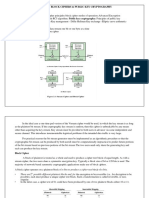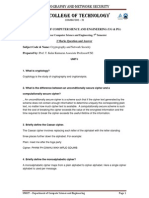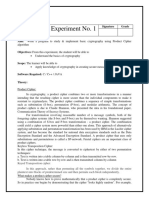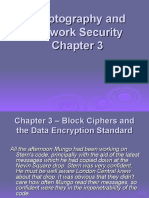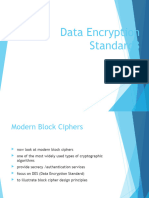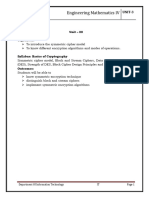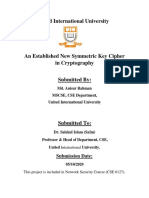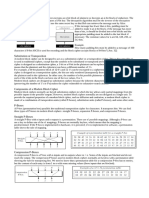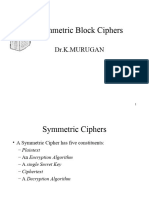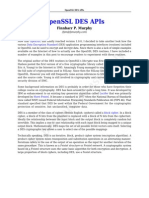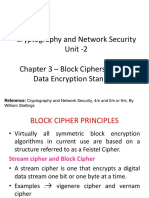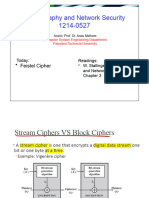3 Chapter4 D E S
3 Chapter4 D E S
Uploaded by
Marah MalaCopyright:
Available Formats
3 Chapter4 D E S
3 Chapter4 D E S
Uploaded by
Marah MalaOriginal Description:
Original Title
Copyright
Available Formats
Share this document
Did you find this document useful?
Is this content inappropriate?
Copyright:
Available Formats
3 Chapter4 D E S
3 Chapter4 D E S
Uploaded by
Marah MalaCopyright:
Available Formats
Encryption and computer
security
B L O C K C I P H E R S A N D D ATA E N C R Y P T I O N S TA N D A R D ( D E S )
CHAPTER 4
AN-NAJAH UNIVERSITY
ADNAN SALMAN
An-Najah University - adnan salman
Topics
Block Cipher Principles
The Data Encryption Standard (DES)
Simplified-DES
DES Details
DES Issues and Attacks
3DES, AES and Other Block Ciphers
An-Najah University - adnan salman
objectives
Modern block ciphers
One of the most widely used types of cryptographic
algorithms
Provide secrecy /authentication services
Focus on DES (Data Encryption Standard)
To illustrate block cipher design principles
An-Najah University - adnan salman
Modern Block Ciphers
A stream cipher: is one that encrypts a digital data
stream one bit or one byte at a time.
Block Ciphers: A block cipher is one in which a block
of plaintext is treated as a whole and used to produce
a ciphertext block of equal length.
Encrypt data one block at a time
Used in broader range of applications
Typical block size 64 – 128 bits 128 bits
Most algorithms based on a structure referred to as Feistel
block cipher
An-Najah University - adnan salman
Block vs Stream Ciphers
An-Najah University - adnan salman
Block cipher principles
n-bits block cipher takes n-bit plaintext and produces
n-bit ciphertext
There are 2n possible different plaintext blocks
Encryption must be reversible (decryption possible)
Each plaintext block must produce unique ciphertext
block
Total transformations is 2n!
An-Najah University - adnan salman
Ideal block cipher
How many possible different keys?
For a block size of n=2, there is a 2n! = 24 different keys
Good, makes harder for brute force attack
What is the length of the key that maps the plaintext
to ciphertext
For a block size of n = 2, the length of the key = n*2n = 8
An-Najah University - adnan salman
Ideal Block Cipher
A 4-bit input produces one of 16 possible input
states, which is mapped by the substitution cipher
into a unique one of 16 possible output, each of
which is represented by 4 ciphertext bits.
An-Najah University - adnan salman
Encryption/decryption table
Block size = n = 4
Key length = n*2n = 64
An-Najah University - adnan salman
Ideal Block Cipher
n-bit input maps to 2n possible input states
Substitution used to produce 2n output states
Output states map to n-bit output
Ideal block cipher allows maximum number of
possible encryption mappings from plaintext block
Problems with ideal block cipher:
Small block size: equivalent to classical substitution cipher;
cryptanalysis based on statistical characteristics feasible
Large block size: key must be very large; performance /
implementation problems
64-bit block require key size of 64 * 264 = 1021
An-Najah University - adnan salman
The Feistel Cipher
Feistel proposed the use of a cipher that alternates
substitutions and permutations:
Substitution: Each plaintext element or group of elements is
uniquely replaced by a corresponding ciphertext element or group
of elements.
Permutation: A sequence of plaintext elements is replaced by a
permutation of that sequence. No elements are added or deleted
or replaced in the sequence, the order of elements is changed.
The essence of the approach is
develop a block cipher with a key length of k bits and a block
length of n bits.
allowing a total of 2k possible transformations instead of 2n!
An-Najah University - adnan salman
Diffusion And Confusion
A strongly ideal cipher: all statistics of the ciphertext
are independent of the particular key used.
Shannon suggests two methods for frustrating
statistical cryptanalysis: diffusion and confusion.
Diffusion: the statistical structure of the plaintext is dissipated
into long-range statistics of the ciphertext. Achieved by having
each plaintext digit affect the value of many ciphertext digits.
Example: Encrypt a message M = m1 , m2 , m3 , ... of characters
with an averaging operation by adding k successive letters to get a
ciphertext letter yn .
An-Najah University - adnan salman
Diffusion And Confusion
A strongly ideal cipher: all statistics of the ciphertext
are independent of the particular key used.
Shannon suggests two methods for frustrating
statistical cryptanalysis: diffusion and confusion.
Confusion: seeks to make the relationship between the
statistics of the ciphertext and the value of the encryption key
as complex as possible, to thwart attempts to discover the key.
Achieved by using a complex substitution algorithm.
A simple linear substitution function would add little confusion.
An-Najah University - adnan salman
Feistel Cipher Structure
Approach:
Plaintext split into halves
Subkeys (or round keys) generated from key
Round function, F, applied to right half to perform
substitution
Apply substitution on left half using XOR
Apply permutation: interchange to halves
Implements Shannon’s S-P net concept
An-Najah University - adnan salman
Feistel Cipher Structure
An-Najah University - adnan salman
Feistel Cipher Design Elements
The exact realization of a Feistel network depends on
the choice of the following parameters and features:
Block size: Larger block sizes mean greater security but
reduced encryption/decryption speed for a given algorithm.
Key size: Larger key size means greater security but may
decrease encryption/decryption speed (greater resistance to
brute-force attacks and greater confusion).
Number of rounds: multiple rounds increases security.
Subkey generation algorithm: Greater complexity lead to
greater difficulty of cryptanalysis.
Round function F: Greater complexity generally means greater
resistance to cryptanalysis.
An-Najah University - adnan salman
Feistel Example
An-Najah University - adnan salman
Data Encryption Standard (DES)
Symmetric block cipher
64-bit input block, 64-bit output block, 64-bit key
One of most used encryption systems in world
Developed in 1977
Used in other ciphers, e.g. 3DES
Simplified DES (S-DES)
Cipher using principles of DES
Developed for education (not real world use)
An-Najah University - adnan salman
Simplified DES
Input (plaintext) block size: 8-bits
Output (ciphertext) block size: 8-bits
Key: 10-bits
Rounds: 2
Round keys generated using permutations and left
shifts
Encryption: initial permutation, round function,
switch halves
Decryption: Same as encryption, except round keys
used in opposite order
An-Najah University - adnan salman
Simplified DES
IP: Initial permutation
fk : A complex, 2-input function
SW: a simple permutation that swaps
the two parts
fk : A complex, 2-input function
-1
IP : Inverse permutation of the IP
An-Najah University - adnan salman
S-DES – Key generation
P10 – permutation:
Input: 1, 2, 3, 4, 5, 6, 7, 8, 9, 10
Output: 3, 5, 2, 7, 4, 10, 1, 9, 8, 6
P8 – Selection and permutation
Input: 1, 2, 3, 4, 5, 6, 7, 8, 9, 10
Output: 6, 3, 7, 4, 8, 5, 10, 9
LS-1 : left shift 1 position
LS-2: left shift 2 positions
An-Najah University - adnan salman
S-DES - Encryption
IP – Initial permutation
EP – Expansion and permutation
S-Box0 and S-box1
An-Najah University - adnan salman
S-DES - Encryption: S-Box
S-DES and DES perform substitutions using S-Boxes
S-Box considered as a matrix: input used to select
row/column; selected element is output
4-bit input: bit1; bit2; bit3; bit4
bit1 , bit4 species row (0, 1, 2 or 3 in decimal)
Bit2, bit3 species column
2-bit output
An-Najah University - adnan salman
S-DES - Encryption
P4 – Selection and permutation
Input: 1 2 3 4
Output: 2 4 3 1
IP-1 – Inverse IP
4, 1, 3, 5, 7, 2, 8, 6
An-Najah University - adnan salman
S-DES Example
An-Najah University - adnan salman
DES Encryption
Algorithm
An-Najah University - adnan salman
Single Round of DES – key gen
An-Najah University - adnan salman
Single Round of DES
key gen
An-Najah University - adnan salman
Single Round of DES – key gen
An-Najah University - adnan salman
DES – Key gen - Example
Original key
K = 133457799BBCDFF1
K = 00010011 00110100 01010111 01111001 10011011 10111100 11011111 11110001
Permuted choice 2
C0 =1111000 0110011 0010101 0101111
D0 = 0101010 1011001 1001111 0001111
Left shift
C1 =1110000 1100110 0101010 1011111
D1 = 1010101 0110011 0011110 0011110
C2 =11000 0110011 0010101 010111111 C3 = 0000110 0110010 1010101 1111111
D2 = 01010 1011001 1001111 000111101 D3 = 0101011 0011001 1110001 1110101
An-Najah University - adnan salman
DES – key gen - Example
C1 =1110000 1100110 0101010 1011111 D1 = 1010101 0110011 0011110 0011110
C1D1 = 1110000 1100110 0101010 1011111 1010101 0110011 0011110 0011110
Permuted choice 2
K1 = 000110 110000 001011 101111 111111 000111 000001 110010
An-Najah University - adnan salman
DES Encryption Algorithm
encryption
An-Najah University - adnan salman
Single Round of DES – Encryption
An-Najah University - adnan salman
Single Round of DES – Encryption
Expansion permutation E
Substitution/choice (S-box)
An-Najah University - adnan salman
DES-Substitution choice - SBox
An-Najah University - adnan salman
Definition of DES S-Boxes
An-Najah University - adnan salman
Des – Encryption – Example
M = 00000001 00100011 01000101 01100111 10001001 10101011 11001101 11101111
IP = 1100 1100 0000 0000 1100 1100 1111 1111 1111 0000 1010 1010 1111 0000 1010 1010
L0 =1100 1100 0000 0000 1100 1100 1111 1111 R0 = 1111 0000 1010 1010 1111 0000 1010 1010
Li = Ri-1
L1 = 1111 0000 1010 1010 1111 0000 1010 1010
Ri = Li −1 f ( Ri −1 , K i )
An-Najah University - adnan salman
Des – Encryption – Example
Expand/Permutation (E – table)
R0 = 1111 0000 1010 1010 1111 0000 1010 1010
E(R0) = 011110 100001 010101 010101 011110 100001 010101 010101
K1+E(R0)
E(R0) = 011110 100001 010101 010101 011110 100001 010101 010101
K1 = 000110 110000 001011 101111 111111 000111 000001 110010
K1+E(R0) = 011000 010001 011110 111010 100001 100110 010100 100111
Substitution Box
An-Najah University - adnan salman
Des – Encryption – Example
Substitution Box
Group results in groups of 6-bits
K1+E(R0) = 011000 010001 011110 111010 100001 100110 010100 100111
= B1B2B3B4B5B6B7B8
Calculate Si(Bi) for i = 1 ... 8
B1 = 011000 = b1b2b3b4b5b6
B1 = 011000 = b1b2b3b4b5b6
Row = b1b6=00 = 0
Column = b2b3b4b5=1100 = 12
S1(B1) = S1[0][12] = 5 S1(B1)S2(B2)S3(B3)S4(B4)S5(B5)S6(B6)S7(B7)S8(B8) =
S2(B2) = S2[1][8] = 12 0101 1100 1000 0010 1011 0101 1001 0111
S3(B3) = S3[0][15]=8
An-Najah University - adnan salman
Des – Encryption – Example
Permutation P
f = P(S1(B1)S2(B2)...S8(B8))
= P(0101 1100 1000 0010 1011 0101 1001 0111)
= 0010 0011 0100 1010 1010 1001 1011 1011
R1 = L0 + f(R0 , K1 )
R1 = 1111 0000 1010 1010 1111 0000 1010 1010
+ 0010 0011 0100 1010 1010 1001 1011 1011
=1110 1111 0100 1010 0110 0101 0100 0100
Repeat these step for the 16 round
This example is taken from here
An-Najah University - adnan salman
A DES example
First row: left and right
halves after the IP
The next 16 rows show the
results after each round.
Final row: The left- and right-
hand values after the IP-1.
An-Najah University - adnan salman
The Avalanche Effect
Desired (Avalanche effect ): small change in the key
or plaintext produces large change in ciphertext.
A change in one bit of the plaintext or one bit of the key should
produce a change in many bits of the ciphertext.
An-Najah University - adnan salman
The Avalanche Effect – Change in Plaintext
number of
bits that
differ
• Bit-4 of the plaintext is changed to 12468aceeca86420.
An-Najah University - adnan salman
Attacks on DES – Brute force
How much time is required for a brute-force attack
for various key sizes.
An-Najah University - adnan salman
Attacks on DES – Brute force
Only 56 bits used in encryption (8-bits parity check)
256 = 7.2 x 1016
1977: estimated cost of $20M to build machine to break it in 10
hours
1998: A machine was built for $250k to break it in 56 hours
1999: break DES in 22 hours and 15 minutes
2016: Single GeForce GTX 1080 Ti GPU (costing < $1000)
recovers a key in an average of 15 days
A chosen-plaintext attack utilizing can recover the DES key for
a single chosen plaintext in 25 seconds
An-Najah University - adnan salman
Attacks on DES – Brute force
Fortunately, there are a number of alternatives to
DES, the most important of which are AES and triple
DES,
An-Najah University - adnan salman
You might also like
- CNS Unit No - 2Document25 pagesCNS Unit No - 2keshab maharajNo ratings yet
- Unit Ii - Block Ciphers & Public Key CryptographyDocument60 pagesUnit Ii - Block Ciphers & Public Key CryptographyAadilNo ratings yet
- Cryptography and Network Security UNIT-2Document38 pagesCryptography and Network Security UNIT-2LAVANYA KARTHIKEYANNo ratings yet
- Data Encryption Techniques and StandardsDocument59 pagesData Encryption Techniques and StandardsRajan Jamgekar100% (1)
- CH 03Document37 pagesCH 03Nguyễn Ngọc TháiNo ratings yet
- UNIT2Document29 pagesUNIT2Evy LawNo ratings yet
- Cryptography & Network SecurityDocument25 pagesCryptography & Network Securityrrs_1988No ratings yet
- Block Ciphers and The Data Encryption StandardDocument38 pagesBlock Ciphers and The Data Encryption Standardkdhwani28No ratings yet
- Unit 2 - Symmetric Key CryptographyDocument30 pagesUnit 2 - Symmetric Key Cryptographyraghatateharshal4No ratings yet
- Block Ciphers: Dr. Md. Mahbubur RahmnaDocument124 pagesBlock Ciphers: Dr. Md. Mahbubur RahmnaimtibdNo ratings yet
- CSS Lab Manual - PrintDocument45 pagesCSS Lab Manual - PrintXavier TxANo ratings yet
- CNS Unit-IIDocument54 pagesCNS Unit-IIRadha RaniNo ratings yet
- 503049-Chapter 10.2 Symmetric Encryption and Message ConfidentialityDocument24 pages503049-Chapter 10.2 Symmetric Encryption and Message ConfidentialityfecotranNo ratings yet
- Cryptography Lecture 2 NotesDocument10 pagesCryptography Lecture 2 NotesShivend MenonNo ratings yet
- PR6 - Data Encryption Standard (DES) Algorithm - OKDocument8 pagesPR6 - Data Encryption Standard (DES) Algorithm - OKPrafulla Durgadhar GawandeNo ratings yet
- Cryptography and Network SecurityDocument37 pagesCryptography and Network SecurityPrachiNo ratings yet
- Lecture 3 Data Encryption Standard (DES) and Advanced Encrption StandardDocument62 pagesLecture 3 Data Encryption Standard (DES) and Advanced Encrption StandardNurdin YussufNo ratings yet
- Lecture 3-Modern CryptographyDocument58 pagesLecture 3-Modern Cryptographyr.arshadr12No ratings yet
- Ch03 Block Ciphers NemoDocument50 pagesCh03 Block Ciphers Nemopitchrks19841No ratings yet
- 5 - DES 15102024 083219amDocument51 pages5 - DES 15102024 083219ammanahil.ba.alamNo ratings yet
- Cryptography and Network Security Lecture 2Document38 pagesCryptography and Network Security Lecture 2sifNo ratings yet
- Group Session Key Exchange Multilayer Perceptron Based Simulated Annealing Guided Automata and Comparison Based Metamorphosed Encryption in Wireless Communication (Gsmlpsa)Document20 pagesGroup Session Key Exchange Multilayer Perceptron Based Simulated Annealing Guided Automata and Comparison Based Metamorphosed Encryption in Wireless Communication (Gsmlpsa)John BergNo ratings yet
- 0711ijnsa15 Blowfish PDFDocument9 pages0711ijnsa15 Blowfish PDFParkerAllisonNo ratings yet
- ch03Document37 pagesch03StanlyNo ratings yet
- CT UNIT 2 Session 1Document31 pagesCT UNIT 2 Session 1HariniNo ratings yet
- Unit2 Cryptography and Cyber SecurityDocument4 pagesUnit2 Cryptography and Cyber SecuritypraveenaNo ratings yet
- Unit1 - Block Cipher PrinciplesDocument21 pagesUnit1 - Block Cipher PrinciplesKrishna ReddyNo ratings yet
- Hash Functions: - Dr. Sanjay H ADocument125 pagesHash Functions: - Dr. Sanjay H ARiddhi SinghalNo ratings yet
- Crypt 2Document24 pagesCrypt 2Saravana KohliNo ratings yet
- Cryptographl Lect4Document20 pagesCryptographl Lect4Ali BallahNo ratings yet
- Cryptography and Network Security: Fourth Edition by William StallingsDocument37 pagesCryptography and Network Security: Fourth Edition by William Stallingskstu1112No ratings yet
- Block Ciphers and Block Ciphers and Encryption Standards Encryption StandardsDocument47 pagesBlock Ciphers and Block Ciphers and Encryption Standards Encryption Standardsกุ๊บ กิ๊บNo ratings yet
- Block CiphersDocument25 pagesBlock CiphersAnkur Agrawal100% (1)
- CH 07Document23 pagesCH 07Koushik AkkinapalliNo ratings yet
- Journal of Cryptology: Differential Cryptanalysis of DES-like Cryptosystems 1Document70 pagesJournal of Cryptology: Differential Cryptanalysis of DES-like Cryptosystems 1LosFantasticosESP TeamNo ratings yet
- Presentation On: Speeding Up Secure Web Transactions Using "Elliptical Curve Cryptography"Document16 pagesPresentation On: Speeding Up Secure Web Transactions Using "Elliptical Curve Cryptography"BrijnandanSingh ChauhanNo ratings yet
- Block Ciphers and The Data Encryption Standard Presented byDocument34 pagesBlock Ciphers and The Data Encryption Standard Presented bySabin BhandariNo ratings yet
- Practical Data Hiding in Tcp/Ip: Kamran Ahsan Deepa KundurDocument30 pagesPractical Data Hiding in Tcp/Ip: Kamran Ahsan Deepa KundurmrasadNo ratings yet
- Main Project SlidesDocument26 pagesMain Project SlidesHari Harul VullangiNo ratings yet
- 137 - CS8792, CS6701 Cryptography and Network Security - 2 Marks With Answers 2Document17 pages137 - CS8792, CS6701 Cryptography and Network Security - 2 Marks With Answers 2Lionel Bharath RazerNo ratings yet
- Network Security EssentialsDocument46 pagesNetwork Security EssentialsFatima AlshareefNo ratings yet
- IS364 - Lecture 09 - Symmetric EncryptionDocument41 pagesIS364 - Lecture 09 - Symmetric Encryptionsamwel sittaNo ratings yet
- NSC Unit 2 Zoom Cls (15-04-2020)Document20 pagesNSC Unit 2 Zoom Cls (15-04-2020)yuvaraaj aletiNo ratings yet
- CNS Unit-IiDocument58 pagesCNS Unit-IinandanNo ratings yet
- Chapter 2 CyptographyDocument52 pagesChapter 2 CyptographyEsta AmeNo ratings yet
- Cryptography and Network SecurityDocument32 pagesCryptography and Network SecurityArya KumariNo ratings yet
- An Established New Symmetric Key Cipher PDFDocument18 pagesAn Established New Symmetric Key Cipher PDFMd. Anisur RahmanNo ratings yet
- AES11Document51 pagesAES11Karthiga MuruganNo ratings yet
- Chap2 CryptographyDocument29 pagesChap2 CryptographyHaslina MahmoodNo ratings yet
- RSA AlgorithmDocument22 pagesRSA AlgorithmmathpalsonuNo ratings yet
- Lec 4Document78 pagesLec 4Rawan AbubakerNo ratings yet
- Des 1Document24 pagesDes 1pritamk6284987295No ratings yet
- Feasibility Presentation PPT Format (1) (Read-Only)Document17 pagesFeasibility Presentation PPT Format (1) (Read-Only)Sudeepti D NandaNo ratings yet
- Module 2 Block CipherDocument74 pagesModule 2 Block Cipherveweta7491No ratings yet
- Cryptography and Network Security HandoutDocument79 pagesCryptography and Network Security HandoutDr Narayana Swamy RamaiahNo ratings yet
- Chapter 3 (Convention Encryption)Document16 pagesChapter 3 (Convention Encryption)subediaanchal28No ratings yet
- Encryption Modes Identification of Block Ciphers Based On Machine LearningDocument10 pagesEncryption Modes Identification of Block Ciphers Based On Machine LearningAIRCC - IJNSANo ratings yet
- Serpent: A Proposal For The Advanced Encryption StandardDocument23 pagesSerpent: A Proposal For The Advanced Encryption StandardscribblenotesNo ratings yet
- Serious Cryptography: A Practical Introduction to Modern EncryptionFrom EverandSerious Cryptography: A Practical Introduction to Modern EncryptionRating: 4.5 out of 5 stars4.5/5 (7)
- Symmetric - Key CryptographyDocument62 pagesSymmetric - Key CryptographyNavneet KumarNo ratings yet
- Cryptography (CS F463) : BITS PilaniDocument46 pagesCryptography (CS F463) : BITS PilanikirtiNo ratings yet
- m03 SymblockDocument4 pagesm03 Symblockrofiwi6692No ratings yet
- Block CiphersDocument34 pagesBlock CiphersDivjot SinghNo ratings yet
- Cryptography-Symmetric - Modern - DeCDocument41 pagesCryptography-Symmetric - Modern - DeCLam CaoNo ratings yet
- Chapter 5Document29 pagesChapter 5Samsung A30No ratings yet
- Modern Block CiphersDocument37 pagesModern Block CipherssunnyNo ratings yet
- 12 Idea 02 02 2024Document79 pages12 Idea 02 02 2024utkarsh.tyagi2021No ratings yet
- Crypto - PPT - Presentation TranscriptDocument4 pagesCrypto - PPT - Presentation TranscriptPartasarathy IyerNo ratings yet
- Des 1Document44 pagesDes 1SK Endless SoulNo ratings yet
- Differential Cryptanalysis On FEAL 4Document10 pagesDifferential Cryptanalysis On FEAL 4Marcu Adrian BercaNo ratings yet
- Feistel CipherDocument4 pagesFeistel CipherNikhil ManeNo ratings yet
- SJB Institute of Technology: Module - 2 Symmetric CiphersDocument67 pagesSJB Institute of Technology: Module - 2 Symmetric Cipherssasindhur rNo ratings yet
- VHDL Code For The Data Encryption StandardDocument66 pagesVHDL Code For The Data Encryption StandardNishtha SharmaNo ratings yet
- OpenSSL DES APIDocument12 pagesOpenSSL DES APIFinnbarr P. MurphyNo ratings yet
- Data Security in CloudDocument9 pagesData Security in Cloudvaibhav vermaNo ratings yet
- Cryptography and Network Security Unit - 2 Chapter 3 - Block Ciphers and The Data Encryption StandardDocument86 pagesCryptography and Network Security Unit - 2 Chapter 3 - Block Ciphers and The Data Encryption StandardAkshit PrajapatiNo ratings yet
- CS-452 Data Encryption & SecurityDocument24 pagesCS-452 Data Encryption & SecurityNomi ChNo ratings yet
- Assignment 1Document5 pagesAssignment 1Vinayak ChachraNo ratings yet
- Cryptomeria c2 SpecDocument9 pagesCryptomeria c2 SpecfisriiNo ratings yet
- This Is The Basis Structure For Block Cipher. DES Encryption and Decryption Algorithms Uses This Structure. This Structure Proposed by FeistelDocument12 pagesThis Is The Basis Structure For Block Cipher. DES Encryption and Decryption Algorithms Uses This Structure. This Structure Proposed by FeistelNaga sai ChallaNo ratings yet
- Abstract. This Paper Presents A 64-Bit Lightweight Block Cipher TWINEDocument24 pagesAbstract. This Paper Presents A 64-Bit Lightweight Block Cipher TWINEاليزيد بن توهاميNo ratings yet
- Feistel CipherDocument11 pagesFeistel CipherManarNo ratings yet
- A Review On Cryptography in Cloud ComputingDocument7 pagesA Review On Cryptography in Cloud ComputingYashil PatelNo ratings yet
- Unit Ii: Block Ciphers & Public Key CryptographyDocument109 pagesUnit Ii: Block Ciphers & Public Key CryptographyDhivyabharathi ANo ratings yet
- 3 Chapter4 D E SDocument47 pages3 Chapter4 D E SMarah MalaNo ratings yet
- Unit IIIDocument55 pagesUnit III20AD022 KAMALI PRIYA SNo ratings yet
- William Stallings, Cryptography and Network Security 3 - eDocument42 pagesWilliam Stallings, Cryptography and Network Security 3 - enupur104btit20No ratings yet
- Lecture13 BlockCipherDocument60 pagesLecture13 BlockCipher22f3000121No ratings yet
- Data Security and EncryptionDocument7 pagesData Security and EncryptionSyed Ali shahNo ratings yet

